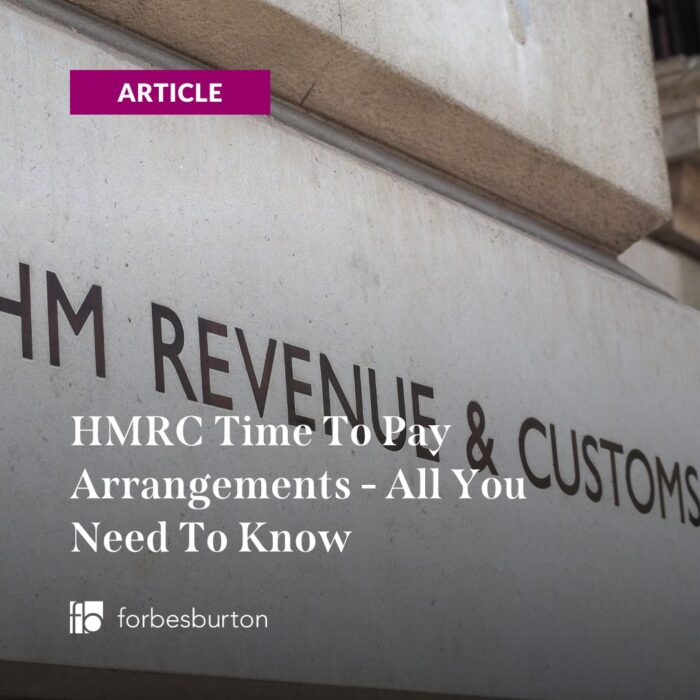
It is easy to ignore a mounting debt problem, but the first point to note is that you should never bury your head in the sand!
Facing the issue head on, and acting quickly may be daunting but anything else will only serve to amplify the problem quicker and make things worse.
You have plenty of options available to you if your business is a limited company and is building up debt, we’ve outlined where you should start and the options to consider.
Types of business debt
First you should establish exactly what your company currently owes, for example;
- Tax Liabilities owed to HMRC, for eg; PAYE, VAT and Corporation Tax (CT)
- Monies owed to suppliers as they’ve offered you credit via factoring/invoice discounting
- Business borrowing, for eg; overdraft, vehicle finance etc.
- Money invested in the business by directors or other, usually in the form of cash, personal loans, or personal guarantees
Once you have gained an insight to the source of the problem, you need to assess the impact of the debt on the business.
If your profit margins are large enough, and there is no issue with cash flow, the outstanding debt is not necessarily an issue as you are likely to be able to pay the amount without too much of a delay.
However, if the level of debt is so high that all profit is being swallowed, or if levels of debt are rapidly increasing, you need to take action.
Not sure how to get your business out of debt?
Find out the best solution to a business debt problem, try our FREE online test now.
Try our online Business Debt Solution test →
Make sure you are not trading if your business is insolvent
Important, check if you are trading whilst your company is insolvent.
There are a few tests that you can undertake to establish this, but essentially, if the business is solvent then you can reasonably expect to be able to pay the money owed without too much delay or affecting profit margins. In this case, you should of course be vigilant, but you are not at risk of wrongful trading.
If your company is insolvent then you need to get professional advice as soon as you can!
If you continue to get credit from suppliers, for example, while knowing that the debt will not be paid back on time, you can lose the limited liability that comes with running a limited company, and could ultimately become personally liable for any business debts that have accrued while you were director.
Also, think carefully before investing further personal funds, especially if they are secured against your home.
If you decide to take action, the company could be in one of two scenarios – where the business continues trading as a going concern and where it doesn’t.
If you want your business to continue trading
If you have taken the decision to continue running your company as a going concern, there are three main routes you can take;
1. Negotiation with creditors
This process could be done formally or informally. Your position will be strong if the business has no assets and little value.
You could set up a payment plan, but ensure that once this has been agreed upon that you stick to it. Sometimes you can get an intermediary to act for you which can make the negotiation easier.
If one of your creditors is HMRC you can look at doing a Time To Pay arrangement, this is where you agree to pay a set amount each month to clear the debt.
2. CVA (Company Voluntary Arrangement)
The services of an IP (Insolvency Practitioner) will be required for the formal CVA route.
They will typically charge £200+ an hour. In this case you will need to present a reasonable argument to the IP showing how you will trade out of the company’s difficulties.
If the process is approved by all parties, 60% of the debt could be written off, and the balance could be settled over a period of a few years if all parties agree to the terms. However, bear in mind that many CVAs fail – most likely due to the fact that the business was flawed in the first place.
3. Administration
Administration should be considered if you know someone that would like to buy the company without its debts.
The business would be run by the IP for a period of time unless the sale is lined up beforehand – the most cost effective method is to put the company into Administration and sell it on the same day.
The company debts will be written off so the new owner will own the business and its assets, but you will lose your shares and investment. There is nothing to stop the new owner from employing you, however, or offering you a consultancy contract.
4. Company restart
Another option is to open a new company and buy the old company’s assets yourself after it has been closed or placed into administration. This is often referred to as a Pre-Pack Administration or Company Restart; be careful though, to get trusted business advice before entering into any of these processes.
5. Fast Track Company Rescue Plan
Fast Track Company Rescue Plans are similar to a CVA in that they consolidate company debt into one monthly manageable payment, however, because they are informal processes they are usually much quicker to set up and much more cost effective.
If you decide to close the business
If you have received business advice (or you would like to shut the business for personal reasons) and come to the conclusion that the company should cease trading, there are two options available to you;
1. Liquidation
Liquidation works in a similar way to administration but without any attempt to sell the business on. Liquidation should always be the first option investigated to close a business.
The company ceases trading and is struck off the register, after any assets have been sold and remaining funds have been distributed to creditors. The process usually costs upwards of £5,000.
2. Company dissolution
The most straightforward way to close a limited company (and therefore the cheapest) is through dissolution, especially in cases where little or no assets are owned. You stop trading, inform your creditors and after 3 months you can apply to Companies House for a voluntary strike off.
You will then need to negotiate with your creditors and explain that they will not gain anything out of chasing the debt. HMRC and any other creditor with a significant debt owing are likely to object the strike off otherwise, delaying the process significantly.
The dissolution process is much cheaper as no IP or liquidator needs to be appointed to take an invasive look into your company affairs, as is the case with liquidations.
Remember that this option is only available to limited company directors, as sole traders are personally liable for their business debts. Similarly, if you have personally guaranteed any of the amounts, or borrowed money personally to invest into the business, these amounts will remain your responsibility.
Not sure how to get your business out of debt?
Find out the best solution to a business debt problem, try our FREE online test now.
Try our online Business Debt Solution test →
Need to talk to someone?
If your business is struggling give us a call on 0800 975 0380 for some free, no-obligation advice.
We’ll go through the different options with you and then help you decide on the best course of action. You can then choose whether you want us to help you or not.
Author

Ben Westoby
ben.westoby@forbesburton.com
Related Articles
We're here for you.
As a dedicated team of Advisers and Consultants our aim is to help you fix the issues and solve the problems within your business.
Find out more →

